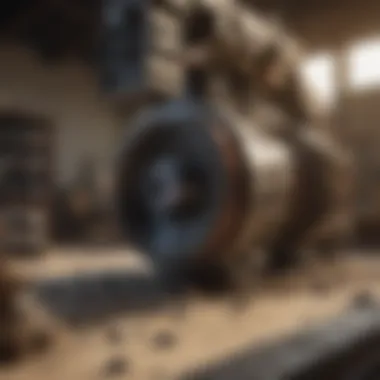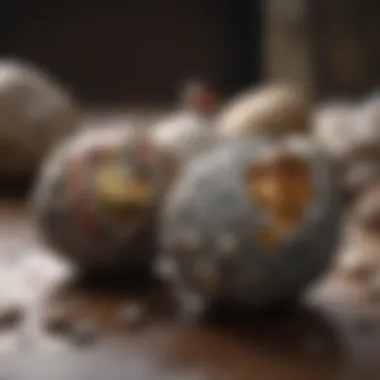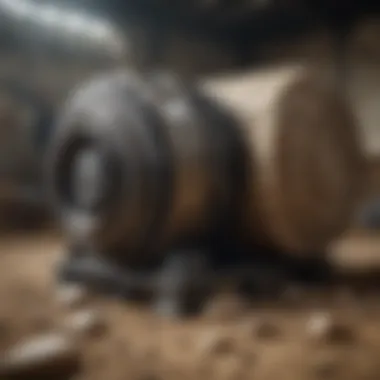Unveiling the Intriguing Dynamics of Tumbled Stone Machinery


Rock and Fossil Identification
Tumbled stone machines can enhance the beauty of various rocks and fossils. Understanding the types of rocks and fossils commonly used in these machines is crucial for enthusiasts. Differentiating between sedimentary, igneous, and metamorphic rocks can provide insight into the characteristics to look for when selecting specimens for tumbling. In addition, recognizing fossilized remains and the preservation methods required to maintain their integrity is key. Utilizing specialized tools for identification, such as magnifying glasses and hardness testing kits, aids in the accurate categorization of materials. The detailed examination and identification process significantly contribute to the quality of the final tumbled result.
Collecting Tips and Techniques
Rock and fossil collecting is an exciting hobby that requires careful attention to best practices. To ensure success in collecting, enthusiasts should familiarize themselves with prime locations for sourcing quality specimens. Researching geological maps and cooperating with local conservation organizations can lead to the discovery of optimal collecting sites. When extracting rocks and fossils from these locations, it is essential to follow safe practices to protect both oneself and the environment. Using tools like chisels, hammers, and brushes with precision minimizes the risk of damaging specimens and ensures a successful collection experience.
Preservation and Display
Once rocks and fossils are obtained, proper preservation techniques are vital to maintaining their aesthetic appeal and scientific value. Implementing methods such as cleaning, drying, and sealing can prevent deterioration and enhance the longevity of specimens. Additionally, employing suitable storage solutions like trays with dividers and acid-free paper aids in organizing and safeguarding collected items. Creative display ideas, such as arranging rocks and fossils in thematic compositions or utilizing shadow boxes with appropriate lighting, can showcase these treasures in a visually captivating manner.
Geological Insights
Delving into the geological aspects of rocks and fossils offers a deeper understanding of their formation and historical significance. Exploring the processes that contribute to the creation of different rock types provides insight into the Earth's intricate geological history. Moreover, uncovering the historical context and notable discoveries surrounding specific rocks and fossils adds a rich layer of narrative to these natural wonders. Understanding the geological insights behind collected specimens not only enhances appreciation for their beauty but also fosters a profound connection with the ancient environmental forces that shaped them.
Introduction to Tumbled Stone Machines
Tumbled stone machines, a cornerstone in the world of rock and fossil collecting, have continuously fascinated enthusiasts with their intricate mechanisms and diverse applications. This section serves as a gateway into the realm of tumbled stone machines, shedding light on their evolution, operational principles, and the impact they have had on the collecting community. By exploring the nuances of tumbled stone machines, readers can deepen their understanding of these complex devices and the role they play in enhancing the beauty of natural specimens.
Evolution of Tumbled Stone Machines
Early Beginnings of Tumbling Technology
The early origins of tumbling technology date back to ancient civilizations, where rudimentary methods were used to smoothen and polish stones manually. These primitive techniques laid the foundation for the development of modern tumbled stone machines, showcasing humanity's enduring fascination with transforming raw materials into lustrous gems. The simplicity and effectiveness of early tumbling methods paved the way for innovations in machine design, shaping the landscape of stone polishing for generations to come.
Innovations in Machine Design
Innovations in machine design have revolutionized the tumbling industry, offering enthusiasts a myriad of options to achieve desired results efficiently. From barrel tumblers to vibratory machines, each design has its unique characteristics, providing distinct advantages in terms of efficiency, speed, and finish quality. The continuous evolution of machine design underscores the industry's commitment to pushing boundaries and exploring new frontiers in stone processing, ensuring that collectors have access to cutting-edge technologies that elevate their craft.
Basic Principles of Operation
Rotary vs. Vibratory Tumbling
The choice between rotary and vibratory tumbling methods is fundamental to understanding how tumbled stone machines operate. While rotary tumblers rely on circular motion to achieve smooth finishes, vibratory tumblers use vibration to agitate the materials, producing equally stunning results. Each method has its strengths and weaknesses, with rotary tumblers excelling in certain applications while vibratory tumblers shine in others. By delving into the nuances of these two techniques, enthusiasts can tailor their approach to stone tumbling for optimal results.


Role of Abrasives in the Tumbling Process
Abrasives play a crucial role in the tumbling process, providing the necessary grit to wear down rough surfaces and unveil the inherent beauty of stones. Understanding the impact of abrasives on different types of stones is essential for achieving desired outcomes, as the choice of grit size and material directly influences the polishing results. By mastering the role of abrasives in tumbling, collectors can unlock a world of creative possibilities, transforming ordinary rocks into dazzling showpieces that captivate the eye.
Popular Brands and Models
Notable Manufacturers in the Industry
The tumbled stone machine market boasts a multitude of reputable manufacturers known for their quality craftsmanship and innovative designs. From established brands with decades of experience to emerging players pushing boundaries, each manufacturer brings a unique perspective to the industry, catering to a diverse range of collector preferences. By exploring the offerings of notable manufacturers, enthusiasts can pinpoint the perfect machine to elevate their stone processing endeavors, ensuring precision, reliability, and exceptional results.
Comparison of Top Tumbled Stone Machines
Comparing the top tumbled stone machines offers collectors valuable insights into the features, performance, and value proposition of leading models. Whether considering factors like capacity, energy efficiency, or specialized functionalities, conducting a thorough comparison equips enthusiasts with the knowledge needed to make informed purchasing decisions. By weighing the advantages and disadvantages of top tumbled stone machines, collectors can align their priorities with the machine that best suits their unique requirements, setting the stage for successful and satisfying stone processing experiences.
Applications in Rock and Fossil Collecting
Understanding the significance of the topic 'Applications in Rock and Fossil Collecting' within this article is pivotal to grasp the practical utilization of tumbled stone machines within the rock and fossil collecting community. This section sheds light on how these machines serve as vital tools for enhancing the visual appeal, preparing surfaces for display, and integrating tumbled stones into jewelry making. By exploring the applications of tumbled stone machines, enthusiasts can elevate their collections to new levels of aesthetic and practical value. In essence, this section acts as a bridge between the technical aspects of tumbled stone machines and their creative applications within the world of rock and fossil collecting.
Enhancing Visual Appeal
Polishing Techniques for Stunning Results
Delving into the meticulous art of polishing techniques unveils a realm where the sparkle and luster of rocks and fossils are enhanced to reveal their true beauty. By employing specialized techniques like rotary or vibratory tumbling, collectors can achieve stunning results that captivate the eyes of beholders. The key characteristic of these techniques lies in their ability to transform rough surfaces into smooth, polished finishes that exude elegance and appeal. The advantages of using such techniques in rock and fossil collecting are profound, as they elevate the overall visual quality of specimens and bring out intricate details that may otherwise go unnoticed.
Creating Lustrous Surfaces on Specimens
Creating lustrous surfaces on specimens is a transformative process that elevates rocks and fossils from raw forms to polished treasures. The specialized techniques involved in this process focus on bringing out the natural shine and beauty of the materials, enhancing their overall appearance. Utilizing methods like abrasive tumbling, collectors can achieve a lustrous finish that highlights the unique characteristics of each specimen. While this process enhances the aesthetic appeal of rocks and fossils, it also serves a practical purpose by protecting the surfaces and ensuring longevity.
Surface Preparation for Display
Smoothing Rough Edges and Surfaces
In the realm of rock and fossil collecting, the importance of smoothing rough edges and surfaces cannot be overstated. This aspect of surface preparation ensures that specimens are not only visually appealing but also safe to handle and display. By employing tumbling techniques that focus on smoothing rough areas, collectors can create a tactile experience for viewers while preserving the integrity of the specimens. The unique feature of this process lies in its ability to harmonize the natural beauty of rocks and fossils with a polished finish that invites exploration.
Removing Imperfections through Tumbling


Tumbling rocks and fossils to remove imperfections is a meticulous process that demands precision and care. By subjecting specimens to controlled tumbling, collectors can eliminate surface blemishes, scratches, and impurities that detract from the overall aesthetic appeal. The key characteristic of this process is its ability to refine the appearance of specimens while maintaining their essential features. However, it is imperative to strike a balance between removing imperfections and preserving the authenticity of rocks and fossils to ensure a harmonious display.
Utilizing Tumbled Stones in Jewelry Making
Transforming Rocks into Wearable Art
Transforming rocks into wearable art represents a creative fusion of nature's beauty with human craftsmanship. By selecting meticulously tumbled stones, artisans can create unique pieces of jewelry that tell stories of geological wonder. The key characteristic of this process is the transformation of raw materials into sculpted gems that adorn the body with elegance and charm. While the advantages of using tumbled stones in jewelry making are numerous, including durability and varied color palettes, artisans must consider factors like stone size, shape, and texture to craft pieces that resonate with discerning collectors.
Design Considerations for Jewelry Crafting
Design considerations play a vital role in the process of jewelry crafting using tumbled stones. From selecting complementary stones to designing intricate settings, every decision shapes the final aesthetic and appeal of the piece. Emphasizing the unique features of tumbled stones, such as their smooth finishes and natural patterns, allows artisans to create jewelry that is not only visually striking but also ethically sourced and environmentally conscious. Understanding the advantages and disadvantages of different design approaches is crucial in ensuring that tumbled stone jewelry stands out in the competitive market while reflecting the essence of rock and fossil collecting.
Impact on Rock and Fossil Collecting Community
In this section, we delve into the pivotal role of impact on the rock and fossil collecting community within the context of tumbled stone machines. Understanding the significance of how these machines influence enthusiasts and professionals alike is crucial for appreciating the broader landscape of this hobby. By exploring the various dimensions of impact, we can grasp the multifaceted nature of tumbled stone technologies in enriching the experiences of collectors, researchers, and artisans in this field.
Educational Outreach and Engagement
Introducing Novices to the World of Tumbling
Delving deeper into the realm of educating newcomers about the art of tumbling stones is a fundamental aspect of fostering interest and skill development in this craft. Whether it involves sharing the basics of machine operation or providing hands-on guidance, introducing novices to tumbling opens up a world of creativity and discovery. By shedding light on the techniques and best practices, novices can build a solid foundation and appreciation for the art of transforming raw stones into polished gems, enhancing their overall understanding and enthusiasm for the hobby.
Workshops and Demonstrations for Enthusiasts
The significance of hosting workshops and demonstrations for enthusiastic individuals cannot be overstated in the context of tumbled stone machines. These practical sessions offer a hands-on approach for enthusiasts to gain valuable insights, refine their skills, and exchange knowledge with like-minded individuals. By facilitating interaction and collaboration, workshops serve as catalysts for innovation and skill advancement, elevating the collective expertise within the community. Moreover, through live demonstrations, participants can witness firsthand the intricacies of tumbling processes, reinforcing their passion and commitment to the craft.
Conservation and Preservation Efforts
Balancing Aesthetics with Ethical Collection Practices
Maintaining a delicate balance between enhancing the aesthetic appeal of stones through tumbling and upholding ethical collection practices is an essential consideration for enthusiasts and professionals. By prioritizing sustainability and responsible sourcing, individuals can ensure that their passion for tumbling stones does not compromise ecological integrity or geological heritage. Finding harmonious synergy between aesthetic pursuits and ethical considerations not only preserves natural resources but also sets a standard of conscientiousness for the wider community to emulate, fostering a culture of ethical stewardship within the realm of rock and fossil collecting.
Importance of Responsible Stone Treatment
The emphasis on responsible stone treatment underscores the ethical dimension of utilizing tumbled stones in various applications. By highlighting the importance of employing gentle and non-invasive treatment methods, enthusiasts uphold the intrinsic value and integrity of each specimen while enhancing its visual allure. Implementing responsible stone treatment practices also ensures that the unique characteristics and geological features of stones remain unaltered, preserving their natural beauty and scientific significance for future generations to appreciate.


Community Building Through Shared Passion
Online Forums and Communities for Exchange
Building a sense of community and fostering dialogue through online forums and digital platforms amplifies the collective knowledge and camaraderie among enthusiasts in the rock and fossil collecting domain. By providing a space for shared experiences, insights, and discoveries, online forums enhance connectivity and collaboration, bridging geographical divides for a global exchange of ideas and expertise. In these virtual spaces, enthusiasts can engage in meaningful discussions, seek advice, and showcase their creations, creating a vibrant ecosystem of learning and interaction.
Collaborative Projects and Exhibitions
Engaging in collaborative projects and participating in exhibitions offer enthusiasts opportunities to co-create, innovate, and showcase their collective talents to a broader audience. By collaborating on various initiatives, individuals can leverage their diverse skills and perspectives to push the boundaries of creativity and expand the possibilities of tumbled stone artistry. Exhibitions serve as platforms for enthusiasts to exhibit their masterpieces, inspire others, and celebrate the beauty of tumbled stones, fostering a sense of pride and community spirit among participants.
Future Trends in Tumbled Stone Technology
In the realm of tumbled stone machines, staying abreast of future trends is paramount for enthusiasts and professionals alike. Understanding the evolution of technology within this niche field allows for enhanced efficiency, productivity, and outcomes. The discussion surrounding future trends centers on pushing the boundaries of traditional practices towards innovative solutions that streamline processes and elevate results.
Integration of Advanced Materials
Emerging Polishing Techniques and Materials:
The integration of advanced materials in the realm of tumbled stone technology heralds a new era of precision and quality. Emerging polishing techniques and materials offer enhanced abrasiveness, leading to impeccable finishing on various stone surfaces. The key characteristic lies in the ability of these materials to deliver consistent outcomes with minimal material wastage, revolutionizing the polishing process. This transformative approach not only boosts efficiency but also ensures a superior final product, making it a popular choice among industry professionals.
Nano-coatings for Enhanced Finish:
The application of nano-coatings for an enhanced finish represents a game-changer in the tumbled stone industry. These ultra-thin coatings provide a protective layer that increases durability and luster on polished stones. The key characteristic of nano-coatings lies in their ability to create a mirror-like sheen while preserving the natural beauty of the stone. This innovative solution offers a sustainable way to achieve exceptional results, making it a favored choice in the industry.
Automation and Digitalization
AI-driven Tumbling Processes:
The incorporation of AI-driven tumbling processes marks a transformative shift towards efficiency and precision. By utilizing artificial intelligence to control tumbling parameters, the process becomes optimized for maximum output with minimal human intervention. The key characteristic of AI-driven processes is the adaptive learning capability that adjusts parameters for optimal results, ensuring consistent quality in every batch. This groundbreaking approach to tumbling is considered a beneficial choice for its unparalleled accuracy and repeatability.
Remote Monitoring and Control Systems:
Remote monitoring and control systems represent the epitome of convenience and precision in tumbled stone technology. These systems enable users to oversee and regulate tumbling processes in real-time from a remote location. The key characteristic lies in the ability to monitor operational parameters and make adjustments on-the-go, ensuring efficiency and adherence to desired outcomes. This innovative feature not only enhances productivity but also offers a level of control that is indispensable in today's fast-paced working environment.
Sustainability and Eco-friendly Practices
Reducing Environmental Footprint in Tumbling:
The focus on reducing the environmental footprint in tumbling processes underscores a commitment to sustainability within the industry. Implementing eco-friendly practices such as water recycling and proper waste management mitigates the impact of stone treatment on the environment. The key characteristic lies in finding innovative ways to minimize resource consumption and waste generation without compromising on quality, thus benefiting both the industry and the ecosystem.
Recycling and Reusing Abrasive Media:
The concept of recycling and reusing abrasive media embodies a proactive approach towards sustainability and efficiency. By repurposing abrasives through recycling methods, the industry reduces waste and conserves resources. The key characteristic of this practice lies in its cost-effectiveness and its contribution to minimizing the environmental impact of tumbled stone processes. This eco-conscious approach not only aligns with sustainable values but also promotes a circular economy within the industry.







